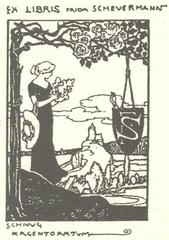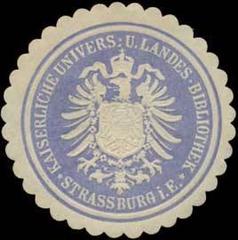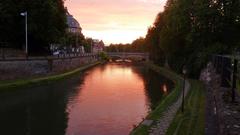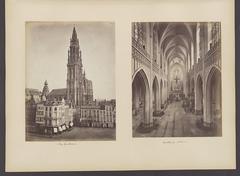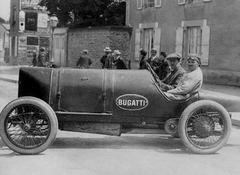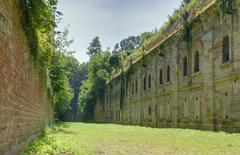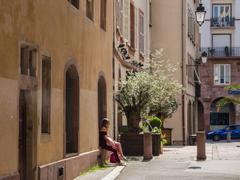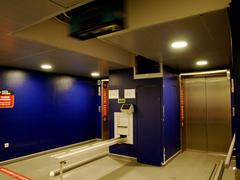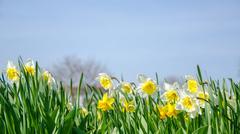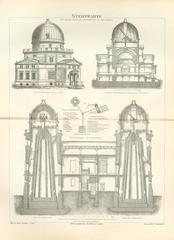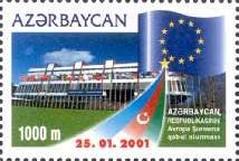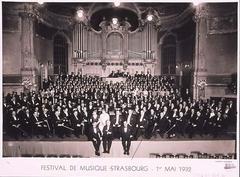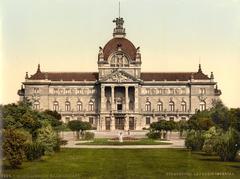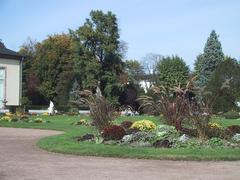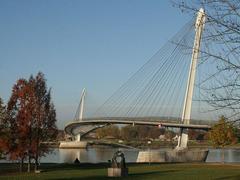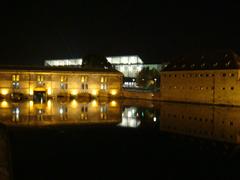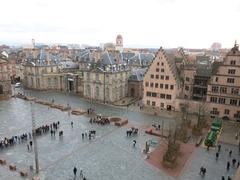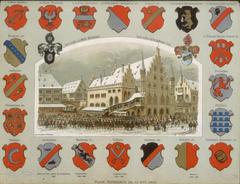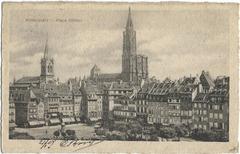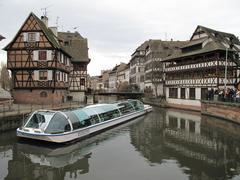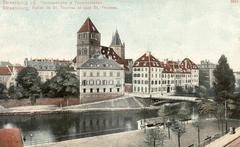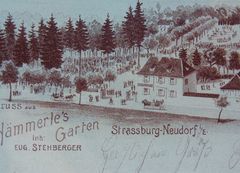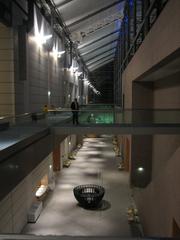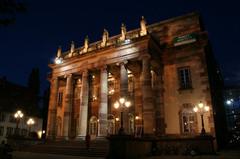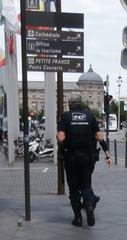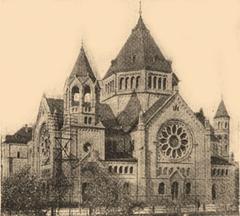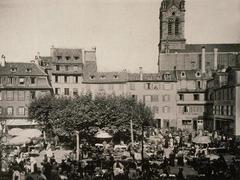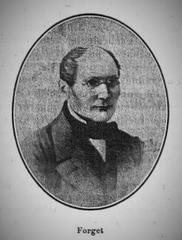Strasbourg Astronomical Clock: Visiting Hours, Tickets, and In-Depth Guide
Date: 15/06/2025
Introduction
The Strasbourg Astronomical Clock, housed within the awe-inspiring Cathédrale Notre-Dame de Strasbourg, stands as a testament to centuries of scientific advancement, artistic brilliance, and cultural exchange. Celebrated as one of the most sophisticated astronomical clocks in the world, it seamlessly unites Gothic architecture, Renaissance artistry, and 19th-century horological innovation. Today, the clock continues to fascinate visitors with its mesmerizing automata display, intricate astronomical mechanisms, and deep symbolic resonance.
Whether you’re a history enthusiast, science aficionado, or first-time visitor to Strasbourg, this guide provides comprehensive details on the clock’s history, architectural and mechanical features, visiting hours, ticketing, accessibility, travel tips, and its enduring cultural significance.
(Wikipedia; Visit Alsace; Strasbourg Tourism)
Table of Contents
- Historical Overview
- Architectural and Artistic Features
- Mechanical and Astronomical Functions
- Automata and Daily Performance
- Visitor Information
- Cultural and Scientific Significance
- Nearby Attractions and Further Exploration
- Frequently Asked Questions (FAQ)
- Summary and Planning Tips
- References and Further Reading
Historical Overview
Origins and Early Development
The Strasbourg Astronomical Clock’s roots reach back to the 14th century, when the first clock (constructed c. 1352–1354) established Strasbourg as a center of innovation in horology and astronomy. Notably, this medieval clock featured automata, including a gilded rooster—now considered the oldest preserved automaton in the world, exhibited in a local museum. Its display of the Magi bowing before the Virgin Mary and Christ Child earned it the moniker “Three Kings Clock.” The clock not only demonstrated advanced mechanical design but also served as a public model of the cosmos for an audience with limited literacy, blending astronomical knowledge with religious symbolism. (Wikipedia; Astronomical Heritage)
By the 16th century, as scientific and artistic sensibilities evolved, the original clock was replaced by a Renaissance masterpiece (completed in 1574). Led by mathematician Conrad Dasypodius and a team of Swiss clockmakers, sculptors, and artists, this second clock introduced a perpetual calendar, astrolabe, planetary indicators, a carillon, and richly painted panels depicting mythological and religious themes. Its celestial globe, zodiac illustrations, and allegorical figures reflected the period’s fascination with the relationship between astronomy, timekeeping, and theology. (Wikipedia)
Renaissance and 19th-Century Innovation
The current clock—the third to grace the cathedral—was completed in 1842–1843 under the direction of Jean-Baptiste Schwilgué, a Strasbourg-born horologist. Schwilgué’s design preserved many Renaissance features while introducing 19th-century advancements such as:
- A fully mechanical perpetual calendar, including Easter date calculation (computus)
- An orrery demonstrating planetary movements
- Real-time displays of solar and lunar positions and eclipses
- Zodiac and celestial globe representations
- Enhanced automata, including the iconic procession of the Twelve Apostles
Schwilgué’s work culminated in a monumental structure nearly 18 meters (59 feet) tall—one of the tallest astronomical clocks in existence. His innovations established the Strasbourg Astronomical Clock as a paragon of scientific and artistic achievement. (Strasbourg Cathedral Official Site; Art Facts)
Architectural and Artistic Features
Location and Setting
The clock occupies the south transept of the Cathédrale Notre-Dame de Strasbourg, itself a UNESCO World Heritage Site and a masterpiece of Gothic architecture (UNESCO). Its soaring, multi-tiered case enhances the cathedral’s interior and is illuminated by natural light filtering through medieval stained glass.
Exterior Design and Materials
The clock’s ornate case is carved from oak, adorned with polychrome sculptures, gilded accents, and painted panels. Corinthian columns, domed canopies, and Renaissance motifs frame the structure, with tiers featuring figures of the Four Ages of Man, the Four Evangelists, and the Four Seasons—many of which are animated during the daily show. Precision-wrought iron, brass, and steel compose the clock’s internal mechanism, some components dating back to the 16th century. (Strasbourg Cathedral Official Site)
Mechanical and Astronomical Functions
Main Time Dial
The central dial, adorned with Roman numerals, displays local time with an ornate hand. The precision pendulum and escapement system ensure remarkable accuracy for a 19th-century clock.
Astronomical Dial and Perpetual Calendar
Located above the main time dial, the astronomical dial reveals:
- Solar time and the sun’s position along the ecliptic
- Lunar phases, indicated by a rotating silver-black sphere
- Positions of the classical planets, as per Ptolemaic cosmology
- Zodiac signs and the precession of the equinoxes
The perpetual calendar tracks the date, day of the week, and key liturgical dates, adjusting automatically for leap years and calendrical variations. (Encyclopaedia Britannica)
Mechanical Innovations
Schwilgué’s mechanism features:
- Gravity escapement for improved timekeeping
- Remontoire, providing consistent mechanical force
- Self-correcting calendar for Gregorian leap year calculation
These innovations, combined with the clock’s astronomical complexity, made it a model for subsequent horological advances. (France.fr)
Automata and Daily Performance
The Strasbourg Astronomical Clock’s animated automata are a highlight for visitors:
- Apostles’ Procession: Daily at 12:30 PM, twelve apostolic figures parade before Christ, who blesses each, as a rooster crows and angels beat their wings.
- Ages of Life: Figures representing childhood, youth, adulthood, and old age pass before Death, symbolizing life’s passage.
- Other Automata: Figures representing days of the week, planetary deities, and allegorical motifs.
The spectacle, lasting several minutes, is often preceded by a short explanatory film (in French with English subtitles), enhancing visitors’ understanding of the clock’s mechanisms and history. (Visit Strasbourg; Mudpie Fridays)
Visitor Information
Visiting Hours and Show Times
- Cathedral Opening:
- Monday–Saturday: 9:00 AM–6:00 PM
- Sunday and public holidays: 12:30 PM–6:00 PM
- Clock Performance:
- Daily at 12:30 PM (except Sundays and public holidays)
- Entry for Show:
- Enter between 11:35 AM and noon at the South portal (Place du Château)
- Arrive early for the best viewing spots, as space fills quickly during peak periods (Kids Are A Trip)
Tickets and Admission
- Clock Show Admission: €3 (as of 2025); tickets at the entrance or in advance
- Strasbourg Pass Holders: Free entry and priority queue access (Big World Small Pockets)
- Cathedral Entry: Free for general admission; separate tickets for clock show and spire climb
- Spire Climb: €8 for panoramic views (332 steps)
Accessibility
- The cathedral and clock are generally wheelchair accessible, though crowds during the clock show may pose challenges for visitors with limited mobility.
- Some upper galleries and the spire climb are not accessible to those with mobility impairments.
Travel Tips
- Photography: Non-flash photography permitted; tripods prohibited during the clock show.
- Film Viewing: The explanatory film is projected to the left of the clock; consider your position if you wish to see both film and performance.
- Nearby Attractions: Explore the cathedral’s stained glass windows, the Pillar of Angels, and the spire for panoramic city views. The cathedral is located in Strasbourg’s historic center, near Grande Île, Palais Rohan, and La Petite France. (Visit Strasbourg)
Cultural and Scientific Significance
The Strasbourg Astronomical Clock is more than a timepiece; it is a living testament to the city’s rich heritage as a center of science, religion, and the arts. Its mechanisms embody the Renaissance ideal of uniting astronomy, mathematics, and theology. The clock’s display of celestial cycles, perpetual calendar, and automata reflect both the scientific curiosity and religious devotion of its creators. Its influence extended across Europe, inspiring the development of public clocks, scientific instruments, and the very conception of standardized time.
As a civic monument, the clock also represents Strasbourg’s wealth and intellectual sophistication, bridging French and German cultural traditions. Today, it remains a dynamic educational tool, a focal point for communal identity, and a symbol of Strasbourg’s enduring commitment to preserving and sharing its cultural treasures. (Academia.edu; Academia.edu)
Nearby Attractions and Further Exploration
While visiting the Strasbourg Astronomical Clock, be sure to explore:
- Strasbourg Cathedral: Gothic architecture, stained glass, and the Pillar of Angels
- Grande Île: UNESCO-listed historic center with medieval streets and canals (UNESCO)
- Palais Rohan: Baroque palace complex with museums
- La Petite France: Picturesque district famed for timbered houses and canals
Frequently Asked Questions (FAQ)
Q: What are the Strasbourg Astronomical Clock visiting hours?
A: The cathedral is open Monday–Saturday from 9:00 AM–6:00 PM, and Sunday/public holidays from 12:30 PM–6:00 PM. The clock performance is at 12:30 PM daily (except Sundays and public holidays).
Q: How much are tickets for the clock show?
A: €3 per person; free with Strasbourg Pass.
Q: Is the Strasbourg Astronomical Clock accessible for visitors with disabilities?
A: The cathedral and clock area are generally accessible, but showtimes can be crowded.
Q: Can I take photos during the clock show?
A: Yes, non-flash photography is permitted; tripods are not allowed.
Q: Where can I buy tickets?
A: At the cathedral entrance or in advance via official sites.
Q: What else can I visit nearby?
A: The cathedral’s spire, Pillar of Angels, Grande Île, Palais Rohan, and La Petite France.
Summary and Planning Tips
The Strasbourg Astronomical Clock is a masterwork of art, science, and cultural heritage—an essential highlight of any visit to Strasbourg. Witness its animated automata at 12:30 PM, marvel at its astronomical displays, and explore the surrounding cathedral and historic center. Arrive early for the show, purchase tickets in advance if possible, and check accessibility if needed. Take advantage of guided tours and educational resources to fully appreciate the clock’s mechanical brilliance and historical significance.
Enhance your visit by downloading the Audiala app for audio guides, updates, and exclusive content. For further reading and up-to-date information, consult the references below or the Strasbourg Cathedral Official Site.
References and Further Reading
- Strasbourg Astronomical Clock (Wikipedia)
- Unlock the Secrets of the Cathedral of Strasbourg (Visit Alsace)
- Strasbourg Astronomical Clock (Strasbourg Tourism)
- Strasbourg Cathedral Official Site
- UNESCO World Heritage Listing for Grande Île
- Strasbourg Astronomical Clock Visitor Information (Visit Strasbourg)
- Astronomical Heritage
- Academia.edu - Cultural and Religious History
- Academia.edu - Scientific and Horological Significance
- Encyclopaedia Britannica
- France.fr
- Mudpie Fridays travel guide
- Kids Are A Trip Strasbourg guide
- Big World Small Pockets Strasbourg guide
Thank you for exploring one of Europe’s greatest horological treasures. For more on Strasbourg’s history and attractions, explore our related articles and download the Audiala app for guided tours and updates.
